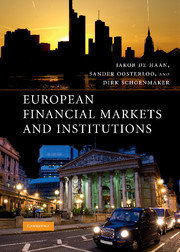Book contents
- Frontmatter
- Contents
- List of Boxes
- List of Figures
- List of Tables
- List of Countries
- List of Abbreviations
- Preface
- Part I Setting the Stage
- Part II Financial Markets
- 3 European Financial Markets
- 4 The Economics of Financial Integration
- 5 Financial Infrastructures
- Part III Financial Institutions
- Part IV Policies for the Financial Sector
- Index
- References
5 - Financial Infrastructures
from Part II - Financial Markets
- Frontmatter
- Contents
- List of Boxes
- List of Figures
- List of Tables
- List of Countries
- List of Abbreviations
- Preface
- Part I Setting the Stage
- Part II Financial Markets
- 3 European Financial Markets
- 4 The Economics of Financial Integration
- 5 Financial Infrastructures
- Part III Financial Institutions
- Part IV Policies for the Financial Sector
- Index
- References
Summary
OVERVIEW
This chapter discusses the payment and post-trading (i.e., securities clearing and settlement) systems in the EU. Over the past decade, the volume and value of transactions that are processed via these systems have grown tremendously. Stable and efficient payment and post-trading systems have become of great importance for the operation of financial markets and the economy in general. At present, these infrastructures are very fragmented and competition is limited.
This chapter starts by examining the different elements of payment and post-trading systems. A distinction is made between retail and wholesale payment systems. Given the growing importance of card-based payment systems, the main focus will be on the set-up of the existing card schemes. Furthermore, the different steps of the post-trading process, which arranges the transfer of ownership and the payment between buyers and sellers in security markets, will be discussed. Finally, the role of central banks in the oversight of payment and settlement systems will be clarified.
The second part of the chapter gives an overview of the economic features of payment and security market infrastructures. These infrastructures are characterised by economies of scale and scope, and network externalities. Understanding these characteristics should enable the reader to better comprehend (future) developments within the EU payment and security market infrastructures.
The third part of this chapter describes: (i) the current situation in the payment and post-trading industry, (ii) the barriers to cross-border payment and security settlement services, and (iii) recent initiatives to promote further integration.
- Type
- Chapter
- Information
- European Financial Markets and Institutions , pp. 135 - 164Publisher: Cambridge University PressPrint publication year: 2009

